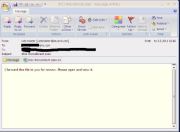Review: Was this the E-Mail that Took Down RSA?
As a ploy to get a hapless EMC recruiter to open up a booby-trapped Excel spreadsheet, it may not be the most sophisticated piece of work. But researchers at F-Secure believe that it was enough to break into one of the most respected computer security companies on the planet, and a first step in a complex attack that ultimately threatened the security of major U.S. defense contractors including Lockheed Martin, L-3, and Northrop Grumman.

Is this the e-mail that spear-phished RSA? The e-mail was sent on March 3 and uploaded to VirusTotal a free service used to scan suspicious messages, on March 19, two days after RSA went public with the news that it had been hacked in one of the worst security breaches ever.
Researchers at F-Secure, the company that discovered the message Monday, believe that it was very likely the message that led to the RSA compromise. If true, the finding sheds light on the kind of trickery, called social engineering by security pros, it takes to break into a major security company.
F-Secure anti-malware analyst Timo Hirvonen discovered the e-mail message buried in the millions of submissions stored in this crowd-sourced database of malicious or potentially malicious files. VirusTotal lets computer users upload a suspicious file, say an Excel spreadsheet that might be infected, and have it scanned by over 40 of the world's top antivirus companies. In return for the free scan, the AV vendors get to examine the files, making the service a great way of learning about malicious software after the fact.
Hirvonen had been searching VirusTotal's database for the RSA attack file ever since RSA acknowledged that it had been compromised. The hackers had sent two different phishing e-mails to small groups of company employees over a two day period, but nobody outside of RSA and its parent company EMC knew the full contents of those messages. It wasn't even clear if they were included in VirusTotal's data.
RSA has released some details about the attack, but Hirvonen's find is a first look at just what it took to get an EMC employee to open that dangerous attachment.
"The e-mail was crafted well enough to trick one of the employees to retrieve it from their Junk mail folder, and open the attached Excel file," wrote RSA Head of New Technologies Uri Rivner in the April 1 blog posting that laid out most of what RSA has said publicly about the e-mail. "It was a spreadsheet titled "2011 Recruitment plan.xls."
Hirvonen didn't know for sure he'd find the e-mail in VirusTotal, but he thought that there was a chance that someone at RSA had uploaded to see what it was. Searching for the 2011 Recruitment Plan spreadsheet yielded nothing, however.
But this month Hirvonen finished up a data analysis tool that allowed him to find his needle in the Virus Total haystack. His technique: he scoured the data for flash objects -- software written to run in Adobe's Flash Player -- that looked like they may have been used in the RSA attack. RSA had previously said that the hackers used software that took advantage of a bug in Adobe Flash and offered some technical details on the attack.
"It was a difficult one to find," Hirvonen said. "We had to work really hard to find it."
With his new tool, Hirvonen quickly discovered a Microsoft Outlook .msg file. When he opened it up, he knew he was onto something. Inside was a message that had been spoofed to look like it had come from recruiting website Beyond.com. "I forward this file to you for review. Please open and view it," the message read. The subject: "2011 Recruitment plan." The attachment: an Excel spreadsheet entitled "2011 Recruitment plan.xls"
Looking closer, Hirvonen found that the file seemed to match RSA's description in possible every way. The Excel file contained the same Flash attack code; It used the same remote control software, called Poison Ivy, and it tried to connect to the same Internet address as RSA's attacker.
The e-mail was sent to EMC employees, apparently in the human resources department, and looked like it came from webmaster@beyond.com, a generic address from a website that has listed EMC jobs in the past. But that was a spoofed address, Hirvonen said. In reality the e-mail wasn't sent from the Beyond.com servers.
F-Secure believes that it's one of the two spearphishing e-mails used to target RSA.
In the past, RSA characterized the hacking incident as an "extremely sophisticated cyber attack," but if this is indeed the e-mail used to break in, it illustrates a guiding principle of these cyber espionage attacks -- the hackers will use anything that works, even simple tricks. If they fail, they will try again and again until they break through.

Artwork: Chip TaylorThe key, security experts say, is in spotting the attackers and keeping them from moving around the network once they've broken in.
Reached Thursday, EMC's RSA Security group was reluctant to say anything about the message. RSA wouldn't say if there were any differences between Hirvonen's e-mail and the one that compromised the company. The company wouldn't confirm that it was the one that got the attackers in, either. "Can we validate that this is the actual e-mail?" said RSA spokeswoman Helen Stefan. "No."
If this was the attack that wedged open RSA's security, it wasn't as sophisticated as others have been, said Alex Stamos, a partner with iSec Partners, a security consultancy that is part of NCC Group. "That's a pretty embarrassing example for RSA," he said. "It tells you that in any reasonably sized company, including a security company, there's someone who will do something really dumb."
More other business:
Tagcloud: E-Mail that Took, RSA , Hp Pavilion DV5 akku , Ibm ThinkPad R51 akku
|
|
